How does change happen in The Church of Jesus Christ of Latter-day Saints? Should it be bottom-up or top-down?
Here’s a little story about a big chapel. Can you guess where it is?
It has a tall white steeple, twin peaked roofs, black grid windows, decorative arches, two-tone exterior paint. Inside, it has varnished wooden pews, a stand, a projector screen, fluorescent lighting, and drapes. It has a row of toilets and a block of porcelain sinks. It has an attached cultural hall and a rear basketball court. It has landscaped grounds and a large parking lot. It looks like a “typical Mormon chapel” that would be at home in Bountiful, Utah.
The problem is, this chapel is in Likasi, a city in the Democratic Republic of the Congo. No one uses the basketball court because sports culture here is all about soccer. The toilets stink because a lack of reliable running water means they don’t get flushed. For the same reason, the sinks don’t work and people wash their hands in a big plastic bucket in the corner of the bathroom. Compared with the modest residences in the neighborhood, the sprawling green lawns seem conspicuously out of place. The parking lot is usually completely empty because few members own a television, much less a car.
When this chapel in Likasi was built, it was built according to a set of standardized building plans used by church administrative offices in Salt Lake City. These plans were descended from a set of architectural types and floor plans that first entered circulation with the creation of the Church Building Committee in 1954.
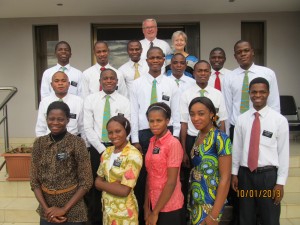
Joy and Phil McMullin with a group of newly arrived missionaries at the Lubumbashi mission home, January 2013.
In 2012, Phil and Joy McMullin arrived at their new mission president post in the Democratic Republic of the Congo (DRC). They both spoke fluent French and so their ability to listen to real conversations was good. They had recently retired from professions as a business owner and as a special needs preschool teacher and so their instincts for problem-spotting-and-solving were sharp. They realized that church buildings that worked in North America were a poor fit for the local environment. Purpose-built LDS chapels looked foreign and ostentatious. They were unhygienic because of the lack of reliable running water. They used expensive non-local materials and construction methods. This building approach was not a past practice, but was guiding current and future building projects.

Contrast between the high steel-and-concrete fence of the new building site and the wood, tin roofs, and mud brick of the neighborhood.
In the course of the McMullins’ service, President McMullin developed a preference for local chapels that had been improvised from existing sites (usually residential compounds). For instance, at a neighboring LDS chapel in Likasi (a former gated home that had been converted), the brick wall and modest building blended into the neighborhood. At this chapel, much of the earth adjacent to the building itself was being used to grow crops. In other places, congregations met outside, holding sacrament meeting in the bamboo grove or Sunday School in the mango grove. Several local residential compounds could be retrofitted into chapels for the same amount of money that it cost to build one new purpose-built “standard” building.
President McMullin and like-minded Congolese colleagues from local church administration took pictures, wrote emails, and brought the matter up in meetings with the leaders directly above them at the Church’s Africa Southeast headquarters in Johannesburg. They appealed to church history: historically, were large, enclosed, multipurpose buildings always used for church meetings? (No, especially before 1847.)
To the credit of all involved, including the area authorities in Johannesburg, good information and common sense proved to be a winning combination. A new chapel is currently being constructed for a congregation in the town of Tshitenge in the DRC that has outgrown its retrofitted-residence meetinghouse.
This new chapel represents a shift in the Church’s approach to building in Africa. Its “four poster” design has shifted away from the standard church building plan and is designed to fit local needs. The main meeting space will be covered by a roof and bounded by a low wall but not completely enclosed. The floor will be pavers in cement. The adjacent bamboo grove will continue to be a place for church life. This new chapel costs much less money to build, will not look ostentatious or foreign, and will accomplish everything that the local unit needs a building to do.
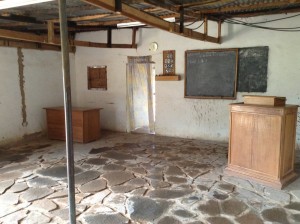
Interior of “old” Tshitenge building (the branch president’s former residence), soon to be replaced by a structure that creates a larger meeting space but that retains a local feel.
This little building is a big story. Not only does it show Mormonism’s increasing ability to adapt to local conditions worldwide, but it is also a sort of a case study illustrating how the global Church changes and adapts to meet the needs of an increasingly diverse membership. First, people on the ground noticed how the existing “standard plan” was not meeting specific needs. Second, in a spirit of stewardship and responsibility, people on the ground identified the problem to church administrators who were in a position to do something about it. Third, armed with this important local knowledge, church administrators very sensibly adapted the policy, coming up with a new approach that matched the resources of the Church with the needs of the Saints.
As is the case with any large organization, we would be delusional if we expected this process to take place quickly. That’s the nature of large organizations, alas.
The key thing to grasp about this “Tale of Two Chapels” is that this inspired adaptation never would have taken place were it not for the considerable initiative of local people on the ground. We can expect that high church leaders will rely on good judgment and divine revelation to make decisions, but it would be unfair to expect them to be telepathic and omnipresent. This is why visiting teachers and home teachers are so important within a ward’s organizational structure. They are the bishop’s eyes and ears on the ground, keeping in touch with individual families and making him aware of any special needs. Grassroots activity in terms of problem-spotting-and-solving can only improve the process of building Zion.
At General Conference in April 2014, Elder Uchtdorf reminded us that the Restoration of the gospel is not something that is complete and already behind us. “Restoration is an ongoing process; we are living in it right now,” he said. “It includes ‘all that God has revealed, all that He does now reveal,’ and the ‘many great and important things’ that ‘He will yet reveal.’”
In the 21st century, change in the Church is not something to be feared, but something to be sensibly expected and facilitated. It is both a bottom-up and top-down process. It is also a horizontal process. When it comes to inspiration, Mormons are accustomed to looking up, but I suggest that we should also look around.


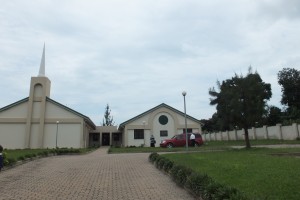
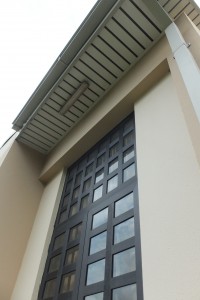
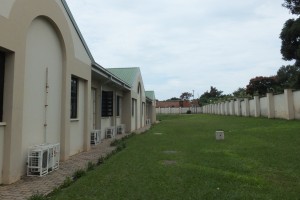
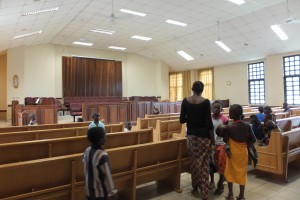



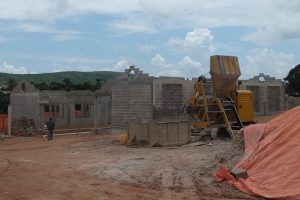

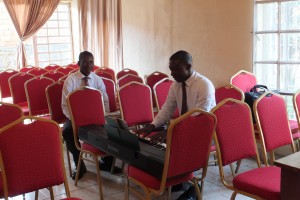
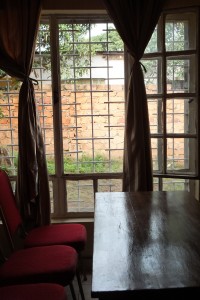


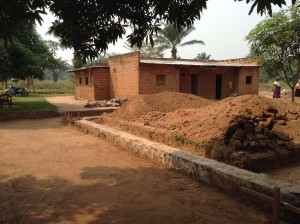




Thanks for the message, this is pretty good! I like your concluding line as I think there is a lot of truth to seeing change in the church coming about by way of community and not just hierarchy. If we want the church to be more open, inclusive, intellectually mature, spiritually mature, etc. we gotta be part of that change ourselves and not just give up responsibility to the hierarchy.
Sounds like the McMullans are good leaders. I will have to ask my friends in the Likasi area what their feelings are. Next week, I will be attending the wedding of a man who worked with Church construction there. His wedding is in Kinshasa. I know that in Gabon, an existing building was used as the branch meeting house.
It’s nice to see the church making changes like this. However, can we really label this as “inspiration?” Inspiration would have been along the lines of realizing when they built the first chapel there that it didn’t meet local needs and actually build something that fit and was practical. What this shows is a feel good example of how businesses adapt, not inspiration.
Not so quick, my friend. Revelation/inspiration is a slow and iterative process: “line up on line…” In my own life, I seldom get the whole message with the first inkling. It is more often that in the doing, in the responding to the first inkling that the follow on inspiration comes. That builds over time into an idea, a talk or a project. Don’t give up on your idea because the details are not clear from the beginning. A careful reading of Nephi building a boat (1 Ne 17 & 18) underscores that he went “oft” to the mountain to pray and receive instruction. So we must likewise understand that our efforts even our very own salvation and exaltation is a work in process requiring trips “oft” to the mountain for further light and knowledge, Phil
How is this any different than how any other business makes changes? The only difference is that the LDS church is much more slow in adapting and being proactive because they wait for this “inspiration” to guide them. Most other businesses simply look at the situation….recognize the flaw….and adapt to the circumstances. It’s not inspiration….it’s reactionary business practices. If it were “inspiration” the church would have been inspired to not waste millions on buildings all over that fall under the same circumstances as this building. It’s interesting that inspired revelation alwYs takes way more time than just using their own brains.
So Phil, if inspiration to build a cost effective, reasonable chapel that fits in and meets the needs of the people requires years of oft trips to the mountain and millions of wasted dollars why even use revelation at all? If The Lord has to be so cryptic on everything and allow for wasteful spending on building after building only to be corrected years later and cost more money then that revelation and inspiration is useless
Garrett, I think you are trying to say that because (a) building the old, expensive and out of place building seems to be an uninspired decision, then (b) the Church is no different than any other large institution and is not what it claims to be, i.e. the true church led by Christ. I completely agree with (a), but completely disagree that it leads to (b). No doubt that taking a US blue print and transplanting it into Africa was an uninspired and, in retrospect, unwise decision. But just because construction decisions are not always inspired, that doesn’t mean that inspiration is not to be found in the Church. From my own experience I know that lots of decisions in the Church are not made by inspiration, but through the well-intentioned decisions of those placed in positions of authority. That doesn’t mean that no callings are inspired or that those making the decisions are never inspired, but I have learned that the Lord generally provides revelation only when it is necessary to provide information that could not be obtained any other way. In nearly all other situations (e.g. the construction of a building) we are expected to act on the knowledge that we have. As a result we often make mistakes, sometimes big mistakes. That doesn’t mean the Lord isn’t in charge of the process, it only means that He cares enough about our growth and agency and is wise enough not to micromanage the process.
So how do we know when inspiration is truly involved in the process? What’s the checks and balances for the process? How do we actually know that The Lord is in charge of the processes? There is no evidence to show that other than individual feelings that make you feel that is the way it is happening. The actual results don’t show anything inspired….they show the workings of an organization that is mostly reactive to anything and everything, as evidenced once again by this article. For having the creator of the universe at the head of the church my feelings tell me that this church should be more proactive and progressive than a reactionary vessel to anything that comes
And no….I never came to the conclusion in what I wrote that the church isn’t true because of this incorrect revelation. I can find plenty of other reasons for that, but you made a jump in your conclusion. Please go back and read what I said and don’t insert words into what I wrote.
Nice job, Melissa. I think the single biggest reason malnutrition exists in the church is because of a lack of knowledge of the problem, from local to general leadership, people just aren't aware of the problem. I really think if we can better educate people about the problem and the solution the problem would go away. But you are certainly right about things taking a LONG time, and that can be very frustrating.
I thought i might ask this question. Here in australia, I find lds missionaries who speak chinese are in the mall and local state library speaking with chinese students. These people have parents steeped in their culture and religion. Is it ethically right to do this when these students would be vunerable and lonly.
I am surprised the basketball courts aren't used for fulbito, which is played on basketball sized courts in Latin American and Africa. Thanks for showing how asessing needs are just as important as adressing needs.
I think The Lord expects us to use our good sense and listen for the “stop, wait, slow down, alter course” messages for the vast majority of these kinds of things. Having dealt with the Office of the Presiding Bishopric in construction projects, saw that the bureaucracy is more business like than revelatory. Not a criticism, just long observation and interface. Many bishoprics and stake councils begin with prayer, but then plow forward with the agenda’s business, and don’t prayer over many particulars. Again, just many observations and direct participation.
Glad to see the church finally getting it right. The locals in South Sudan tried hard to get the administration to listen to us when they were building the chapel in Juba but they ignored our feedback. Not only does the chapel sick out like a sore thumb, but the toilets were confiscated by the neighbors who had no facilities, to the point where they were so dirty we could never use them. I hope in the future this DRC success becomes the norm rather than an outlier.
Melissa, you make a number of good points. One size does not fit all, at least not very well.
Melissa,
You are a great blessing being there & writing about what you see. Thank you so much for sharing your experience with the rest of us – not there; giving us the opportunity to learn from your experience and through your heart as well. Take good care of yourself.
I share one adage, in case you haven’t heard it before. “Work as if it all depends in you while prating like it all depends on God”.
It's not just a problem in foreign countries. In 1986 we moved to a new Ward in Mesa Arizona. When it was completed it had already been out grown. I remember trying to teach 15 girls in small class rooms with no window knee to knees. They sent us a snow blower, anyone knows it doesn't snow in Mesa, well almost anyone.
Recently I visited a beautiful meetinghouse in North Carolina that was one of the very newest designs. Alas, it seems the church architects have STILL not figured out that in many climates, a simple PORTE COCHERE is needed to let cars drop off the elderly, disabled, or parents with babies, because it RAINS ALL THE TIME.